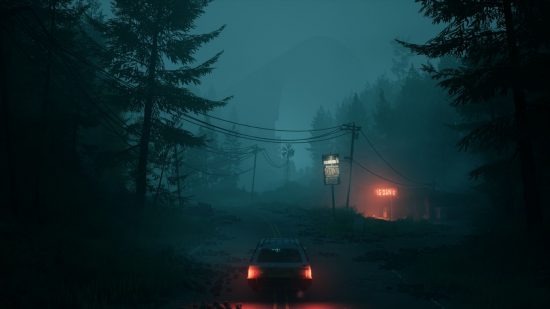Despite never physically meeting a single character in Pacific Drive, conversing with them and listening in on their anecdotes is an unexpectedly heartwarming occasion during my preview of the game.
Ironwood Studios’ debut survival game with a twist sees you heading off the beaten path in a strangely eerie locale within the Pacific Northwest. Booting up Pacific Drive, a series of infographics tells of the Olympic Peninsula in 1947 becoming a staging ground for a “promising new technology” – a process hindered by stories of overnight evacuations, mysterious disappearances, and “unnatural encounters.”
Eight not-very-short years later, a section of the area was walled off to become an exclusion zone which would expand over the following 30 years, eventually becoming entirely inaccessible. Of course, the Olympic Exclusion Zone is completely fictitious, but Ironwood’s attention to detail has me hooked. What happened in there?
Unfortunately, I’m still none the wiser – my preview playthrough was capped at the first two story missions. But what happened within those missions has me eager to jump back in and explore the full version of the game when the Pacific Drive release date comes around. My journey begins south of the barrier wall in 1998, with nothing but a clipboard and some vague delivery instructions. I launch my battered old vehicle forward and follow the only available path, during which a short tutorial teaches me how to use my wipers and lights, as well as reminding me to put the car in ‘park’ when needed.
As the rain gets heavier I’m soon forced off-road, where mists begin to pool around me and my environment eerily crumbles out of my vision. As the mists turn crimson and begin to engulf me, my car cuts out and I’m plunged into complete darkness. I suddenly feel very alone. Before I can acclimatize, a bright red light illuminates my surroundings and I’m yanked sideways through a portal.
I come to in the Olympic Exclusion Zone itself, complete with unsettling green mists and crackles of radiation, and immediately sprint forward as the UI urges me to get to safety. When I find an abandoned vehicle, I quickly learn that opening the car and getting in the car are both controlled with the same key, differentiated by a long press or a tap. I tentatively proceed forward before an unexpected voice pierces through the silence. This is the first time I meet Tobias Barlow.
“The signal, yes, it’s back!” he shouts. He explains that he and his colleague, Francis Cooke, are in Sector B in the Mid-Zone. He informs me that my “distress signal” is being picked up in the Outer Zone, Sector E to be precise. Of course, that means my newfound friend isn’t near me at all, and with no way of communicating back to him, I’m still alone.
A friendly voice in the intercom is comforting and takes the edge off my solitude. Tobias identifies me as a “breacher” – someone from outside the barrier wall, and wonders aloud how I’ve managed to enter the Exclusion Zone. Nevertheless, I’m grateful that my lonely, solo venture now has a much more collaborative feel to it.
As I head east towards shelter, Tobias spots a blip on a device he and Francis seem to be observing – a spectrometer. He speculates that this could be a ‘Remnant’ I’m not given any more information than that, but Francis insists it can’t be as they’ve not witnessed one in decades. They quickly establish, thanks to the speed I’m going, that I am possibly the one to have found the Remnant and that it’s taking the form of a car.
The conversational back and forth between Tobias and Francis paints a picture of the history I’ve been thrust into. It’s the perfect encapsulation of Ironwood’s efficient use of characters, even though they’re exclusively off screen.
As I near a shelter, Tobias warns me of Oppy, another unseen character who may not like me “poking around” inside her auto shop. Sure enough, as soon as I turn the power on she greets me with a disgruntled sigh, and then yells “you’ve got five seconds to get the hell out,” before my new friend, Tobias, reassures her via an emergency broadcast that I’m not looking for trouble.
His message also explains that Oppy is actually Dr Ophelia Turner, and I can picture her already. A short woman with erratically-cut, brightly-colored hair, a messy pair of overalls, and large, stomping boots. She’s probably stood with her hands on her hips, furious at my unexpected intrusion, and more furious at Tobias’ threat of reciting his entire anthology of poetry to her if she fails to keep me safe.
Oppy mentions a series of “unfortunates” who have been zapped through to the Exclusion Zone in the past, giving me more context to just how I’ve ended up in this fickle scenario. After reluctantly agreeing to let me scrounge around for scrap and spare parts near her garage to fix up my car, she explains the game’s map system and missions to me. I feel like she’s warming to me, and considering we met barely two minutes ago, this almost doesn’t seem worthy of the sense of achievement I feel. She’s even giving me tips!
Throughout the first two story missions of Pacific Drive, there’s an overarching danger of feeling entirely alone. With limited factors incentivizing me to drive away from the safety of Oppy’s auto lot, I could be tempted to just put Pacific Drive down and leave it well alone. But these three characters, despite never physically meeting them, serve much more of a purpose than your standard game tutorial. They’re going to be my closest support in this strange world, and I can’t wait to see if we meet in the flesh later down the line.
As we wait for Pacific Drive to get here, try some of the other best horror games. You might also want the best story games on PC.




